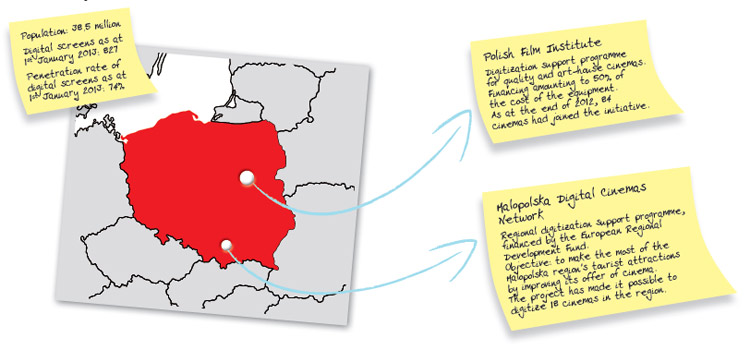Getting ready for DigiTraining Plus 2013: Polish cinema in figures

With over 38 million tickets sold and a total of almost 1,200 screens, Poland is one of the leading markets in Central-Eastern Europe.
As to the new technologies, with 592 digital screens, at the start of 2012 Poland proved to have converted around half her screens.
The figures available for 2013 have shown a further increase (+39.7%) in the number of digital screens, which, at 1 January 2013, came to 827 and now represent three quarters of Poland's total screens.
Since the installation of the first digital projector in Warsaw in 2007, the transition to the new technologies has proceeded rapidly and Poland is now approaching 100% digitalization.
Poland: a variety of economic models for different types of cinemas
This process has been made possible thanks to different economic models.
On the one hand, the country's three leading exhibitors - Multikino, Helios and Cinema City - have now completed the conversion of their screens. Multikino had already digitalised its 208 theatres in 2011, and at 30 June 2012 it counted 223 screens, all of which digital.
Helios, 149 screens, and Cinemacity, 339 screens, instead, completed their 100% digital transition over the first six months of 2012.
If the big chains are able to digitalize using their own resources, several public support schemes have been made available at a national and local level for smaller and commercially weaker cinemas.
In June 2011 the Polish Film Institute launched a programme of support for digitalization specifically addressing quality and arthouse cinemas, with the objective of creating exhibition spaces with a cultural role, which were at the same time in the avantgarde in terms of screening technologies.
To obtain this financing cinemas must first join the Arthouse Cinemas Network, demonstrating that their programming focuses mainly on European and domestic productions (25% of screenings must be Polish films and at least 10 titles must be first-time releases in the year in question).
Moreover, the cinema must prove that at least 300 films are screened per year and that it carries out work on visual education.
If the application is accepted, the cinema receives financing to cover 50% of the cost of digital equipment (amounting to around 40,000 euros according to estimates of the costs for projectors) and becomes part of the Polish Digital Cinema Network: website www.c-kino.pl .
At the end of 2012, 84 cinemas had joined the initiative.
As well as this national financing scheme, in Poland there are also regional initiatives in support of digitalization.
Amongst the latter, the project "Malopolska Digital Cinemas Network" deserves mention. The project was launched in 2010 as an initiative of the Fundacja Rozwoju Kina, an organization supporting the cinema sector with its headquarters in Krakow.
The special characteristic of this initiative is that the movie theatre is considered a key element in the tourist attractions of a given area. Starting out from this assumption, the project, supported by the European Regional Development Fund (ERDF) aims to enhance the attraction of the regions of Lesser Poland to tourists - in particular smaller places - by improving the offer of cinema.
The financing covers 75% of the net costs of conversion: the purchase of the projector and server, adaptation of the sound system and the work needed to adapt the screening room, as well as the installation of 3D technology. Thanks to this scheme it has been possible to digitalize 18 cinemas in the region of Lesser Poland.

(Click here to see tables and graphs)